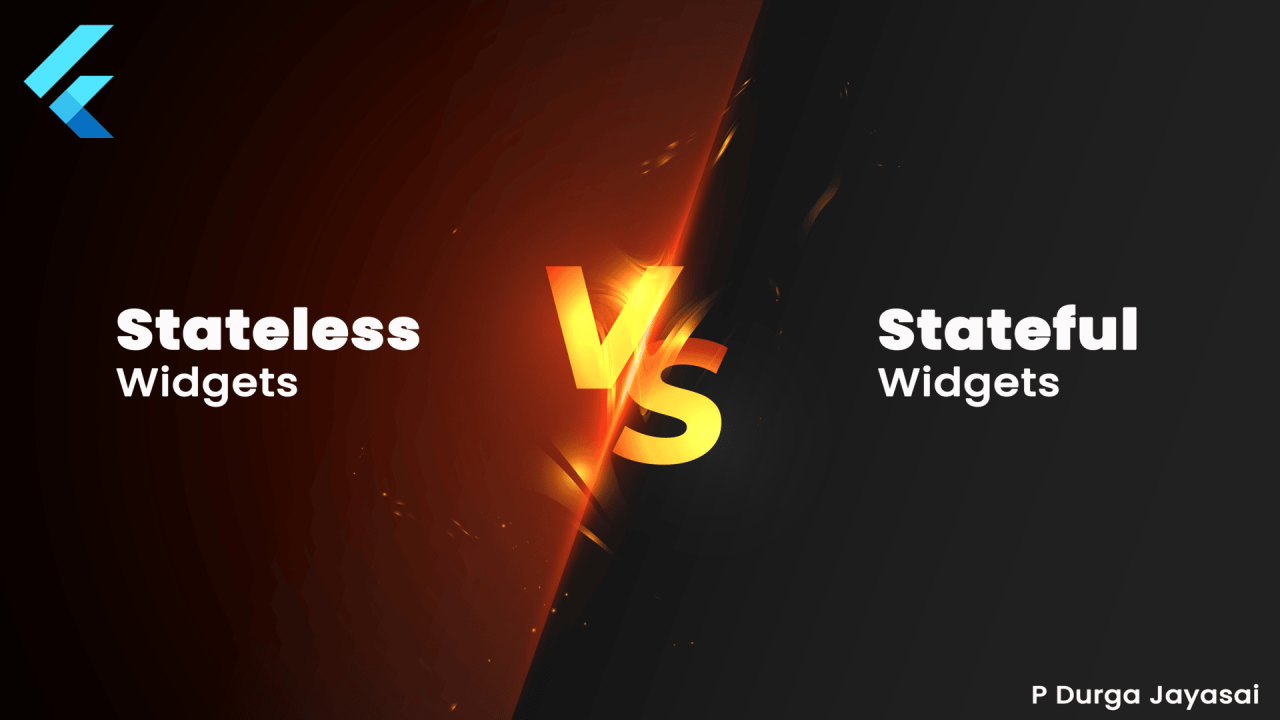
Stateless vs Stateful Widgets in Flutter: Understanding the Difference with Examples
Durga jayasai Pillagolla
Building WorkWave || Student at KL University || Student Peer Mentor || Advisor at Kognitiv club
Widgets are the basic components of the user interface that you design when building apps in Flutter. One of the most basic ideas you will come upon is the difference between stateful and stateless widgets. Although they have different functions, both are essential when designing interactive and responsive user interfaces. The primary differences between these two kinds of widgets will be explored in this article, along with instances to help you understand when to use each.
What is a Stateless Widget?
A stateless widget is a widget that constructs a configuration of other widgets to define a portion of the user interface. Stateless widgets, as their name implies, are immutable once they are constructed and cannot be modified over time. Because of this, they are perfect for showing static content that doesn't need to be updated or changed by the user.
Key Characteristics of Stateless Widget:
Example of a Stateless Widget:
class Stateless extends StatelessWidget {
const Stateless({super.key});
@override
Widget build(BuildContext context) {
return Scaffold(
appBar: AppBar(
title: Text(
"Stateless Widget",
style: TextStyle(
color: Colors.black, fontWeight: FontWeight.bold),
),
),
body: Center(
child: Text(
"Example Text",
style: TextStyle(fontSize: 20),
),
),
);
}
}
The widget simply displays a static message on the screen. No user interaction or state change happens. The widget does not change once it’s rendered.
What is a Stateful Widget?
However, a stateful widget is a widget that has the ability to change over time in response to input from the user or other sources. During the widget's lifecycle, it keeps track of a state object that is subject to updates. When a stateful widget's state changes, the widget is rebuilt to reflect the changes, and the setState() method is called.
Key Characteristics of Stateful Widget:
Example of a Stateful Widget:
领英推荐
class Stateful extends StatefulWidget {
const Stateful({Key? key}) : super(key: key);
@override
_StatefulState createState() => _StatefulState();
}
class _StatefulState extends State<Stateful> {
int _counter = 0;
void _increment() {
setState(() {
_counter++;
});
}
@override
Widget build(BuildContext context) {
return Scaffold(
appBar: AppBar(
title: Text(
"Stateful Widget",
style: TextStyle(fontWeight: FontWeight.bold),
),
),
floatingActionButton: FloatingActionButton(
onPressed: _increment,
shape: RoundedRectangleBorder(borderRadius: BorderRadius.circular(50)),
tooltip: 'Increment',
backgroundColor: Colors.cyanAccent,
child: const Icon(Icons.add),
),
body: Center(
child: Column(
mainAxisAlignment: MainAxisAlignment.center,
children: [
Text(
"Button tapped $_counter times",
style: TextStyle(fontSize: 20),
),
const SizedBox(
height: 10,
),
],
),
),
);
}
}
In this example, the widget contains a button that increments a counter every time it’s pressed. The counter is part of the widget’s state, and the UI updates whenever the state changes.
Key Differences Between Stateless and Stateful Widgets
When to use Stateless Widget
For user interface elements that don't change over time, stateless widgets are suitable. When your application merely has to render static content, use stateless widgets, like these:
When to use Stateful Widget
Stateful widgets should be used when you need to maintain state that changes during the widget’s lifecycle. Common scenarios include:
Conclusion
It's crucial to understand how to distinguish between stateless and stateful widgets when developing effective and manageable Flutter apps. Stateful widgets are good for developing interactive elements that must update in response to user input or other changes, whereas stateless widgets work good for presenting static content.
Understanding when and how to use each sort of widget will assist you in writing cleaner, more efficient code as you build more complex applications. Developing proficiency with this differentiation is essential to improving as a Flutter developer.
You are free to tweak it according to your own design! If you require any specific components altered or additional examples added, please let me know.
Undergrad @ KL University | AWS x 1 | Salesforce x 1 | Director of Technology at kognitiv club
6 个月Insightful
Student Peer Mentor at KL University || President of Kognitiv Technology Club || 1X AWS || 1X Oracle || Red Hat EX-183 Certified
6 个月Insightful
Backend Intern@Safertek || Ex-LLM Python Engineer@Turing || Ex-SoftwareDev@TogetherEd || 3? CodeChef || Finalist @TechgigCG'23 || Advisor@Kognitiv Club || Gold Medalist and Topper in Java Programming(NPTEL)
6 个月Very informative